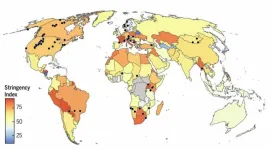(Press-News.org) Despite reports of families disintegrating under the hardships and constraints of the COVID-19 pandemic, a new study suggests that many families may have formed stronger bonds instead.
One key difference between families that emerged from the pandemic stronger and unified compared with those that struggled was having a cohesive, family-oriented mindset. Families in which individuals perceived themselves as members of a team who were working for their collective benefit and found personal fulfillment in meeting the wants and needs of the other members were more likely to improve their family’s well-being during the pandemic, the researchers found.
Published in the Journal of Marriage and Family, the findings come from a nationwide survey of more than 590 people conducted in September 2022 that explored changes in family relationships during the pandemic and identified the factors associated with resilient families.
“Although many studies have examined resilience in individuals in the aftermath of the pandemic, our study is one of the first to investigate resilience at the family level,” said first author Allen W. Barton, a professor of human development and family studies and an Extension specialist at the University of Illinois Urbana-Champaign. “Prior scholars have theorized about the importance of a cohesive family mindset for promoting resiliency when families face adversity, but empirical research investigating this idea has been almost nonexistent.”
Barton’s co-authors were Scott M. Stanley, a research professor and co-director of the Center for Marital and Family Studies at the University of Denver; and U. of I. graduate students Noah B. Larsen and Qiujie Gong.
In the study, individuals were asked how aspects of their family life had changed during the pandemic – specifically, their marriage or current romantic relationship, their relationships with their children and other immediate family members they lived with, as well as those with members of their extended family.
Respondents provided information about various individual and family-level factors that could characterize pandemic-related changes in well-being, such as destructive communication patterns, how much they felt their spouse or partner appreciated them, and levels of perceived stress, loneliness and financial hardship.
The participants, who were recruited through the research survey firm Prolific, were over age 18, parenting at least one child between the ages of 4 and 17, currently in a romantic relationship and U.S. residents.
A slight majority (53%) of the participants were women, who ranged in age from 24 to 75, were white (88%), married (82%) and with a median household income between $75,000 and $85,000, according to the study.
Using the analytic technique of latent profile analysis, which grouped participants based on similarities in their responses to four COVID-19-related questions, the researchers identified three groups of families – those whose functioning worsened across multiple family relationships, who composed about 10% of the sample; those whose family well-being improved (42%); and those whose family dynamics remained stable (48%).
The researchers looked at several variables as potential predictors that differentiated individuals in these three family groups, including individual and demographic factors such as income, education level and financial hardship, along with family-level factors such as couples’ communication, their levels of social integration, their perceptions of their partners’ gratitude toward them and a cohesive family mindset.
The study results showed significant differences among the groups for several couple and family factors but few differences in the individual and demographic factors. However, only one variable significantly differentiated individuals across the three family groups – a cohesive family mindset.
Those in the improved family functioning group reported the highest levels of this mindset, while those in the worsened family functioning group reported the lowest levels of it, the researchers found.
“During times of adversity and hardship, orientations to family life that emphasize teamwork and personal fulfillment through meeting the needs and wants of the broader family unit, versus meeting the needs and wants of oneself, may provide a unique strength-based asset for families,” Barton said.
As individuals adopt this type of mindset, their personal desires may align with familial investments, the researchers hypothesized in the study.
“A cohesive family mindset creates a home in which the sacrifices necessary for the good of the family are not a barrier to one’s happiness, but another means by which happiness can be realized,” Barton said.
Individuals in the worsened functioning group indicated their family members engaged in more destructive communication during conflicts, such as heated arguments and incivility; and the adults had lower levels of perceived gratitude from their partners than those in the other two groups, who scored similarly on both factors, according to the study.
Likewise, the researchers found that individuals in the worsened family functioning group had higher levels of both perceived stress and loneliness compared with their peers in the improved family functioning group.
END
Families with a team mindset strengthened their bonds during COVID-19 pandemic
2023-08-25
ELSE PRESS RELEASES FROM THIS DATE:
New human cell-based 3D model reveals insights into how immune cells contribute to Alzheimer’s disease
2023-08-25
Key Takeaways
Researchers developed a new 3D model of Alzheimer’s Disease that allows them to study the role of immune cells in the disease
They found that infiltration of immune cells significantly increases in brains with AD pathology and contributes to neurodegeneration and neuroinflammation
The team also identified potential strategies to halt this process, which could lead to the development of new therapies
BOSTON – Cognitive decline associated with Alzheimer’s disease (AD) develops when neurons begin to die, which can be caused by inappropriate immune responses and excessive ...
Spending on mental health services has risen by more than 50% since beginning of pandemic
2023-08-25
Spending on mental health services among Americans with private health insurance has surged since the beginning of the COVID-19 pandemic, continuing to rise even as the use of telehealth has plateaued, according to a new study.
Spending on mental health services rose by 53% from March 2020 to August 2022 among a large group of people with employer-provided insurance, according to researchers from the RAND Corporation and Castlight Health. During the same period, use of mental health services increased by 39%.
The researchers say it is uncertain if the trend will continue since some rules that expanded payment for telehealth ...
Patient experiences with hospitals worsened during first two years of pandemic
2023-08-25
The experiences of patients hospitalized during the COVID-19 pandemic was significantly worse than in the years before the crisis, with hospitals with higher staffing levels holding on to better scores longer, according to a new RAND Corporation study.
Patients particularly reported worse staff responsiveness and hospital cleanliness, possibly reflecting staffing shortages in the hospital workforce and the effects of protocols needed to limit the spread of COVID-19, according to researchers.
Deficits were largest for hospitals that in the pre-pandemic period were lower-performing and had lower staffing levels. ...
Changes in patient experiences of hospital care during the pandemic
2023-08-25
About The Study: The results of this study suggest that higher-staffed and higher-performing hospitals were more resilient to the conditions of the COVID-19 pandemic, but by late 2021, patients’ experience of care had declined in all hospitals.
Authors: Marc N. Elliott, Ph.D., of the RAND Corporation in Santa Monica, California, is the corresponding author.
To access the embargoed study: Visit our For The Media website at this link https://media.jamanetwork.com/
(doi:10.1001/jamahealthforum.2023.2766)
Editor’s Note: Please see the article for additional information, including other authors, author contributions ...
COVID-19 pandemic and associated inequities in heart attack treatment, outcomes
2023-08-25
About The Study: This study found that while the pandemic was associated with worse treatment and outcomes in patients with acute myocardial infarction (AMI; heart attack), race and ethnicity–associated inequities did not increase significantly. These findings suggest the need for additional efforts to mitigate outcomes associated with the COVID-19 pandemic for patients admitted with AMI when the hospital COVID-19 burden is substantially increased.
Authors: Laurent G. Glance, M.D., of the University of Rochester ...
Tides may be responsible for up to 69% of under-ice melting in an Antarctica ice shelf
2023-08-25
The ice shelves — the marine-terminating glaciers of the Antarctic Ice Sheet — are melting, and it's not just because of rising atmospheric temperatures. In a one-two punch, ice shelves in Antarctica are fighting a losing battle against rising temperatures both at the surface and under their body. Called basal melting, oceanic heat and compression contribute to the phenomenon, but tides may play a bigger role than previously thought, according to a multi-institution research collaboration based in China. Based on observational data in Prydz Bay, which ...
PolyU scholar’s transformative work on the Leidenfrost effect wins the Falling Walls Science Breakthroughs of the Year 2023
2023-08-25
Prof. Zuankai WANG, Associate Vice President (Research and Innovation) and Chair Professor of Nature-Inspired Engineering at The Hong Kong Polytechnic University (PolyU) has been bestowed one of the 10 winners of the Falling Walls Science Breakthroughs of the Year 2023 in Engineering and Technology category for his groundbreaking work on resolving the Leidenfrost effect.
The Award aims to foster research and innovation across all disciplines by celebrating cutting-edge discoveries. The Falling Walls Foundation, based in Berlin, established the Award to acknowledge the most recent breakthroughs in science and society worldwide.
Prof. WANG’s ...
Half as many AF patients dying of heart attacks and strokes in the UK
2023-08-25
University of Leeds news
Embargo: 25 August 2023, 12.30pm CEST
Patients living with one of the UK’s most common heart rhythm conditions are 50% less likely to die from a heart attack or stroke than they were at the start of the millennium, new research has found.
Analysis of the health records of more than 70,000 patients newly diagnosed with atrial fibrillation (AF) showed that mortality from related cardiovascular and cerebrovascular diseases more than halved over the 16-year study period.
AF is associated with an increased risk of stroke.
The research showed that dementia ...
The corona lockdowns changed the behavior of wild animals around the world
2023-08-25
In the spring of 2020, one country after another went into lockdown as Covid-19 spread across the globe. In some places, e.g. China, the civilian population was kept inside by the authorities. Other countries, like Spain, had a curfew in place for weeks, during which only short trips to the supermarket were allowed.
The lockdowns meant there were suddenly much fewer cars on the roads and people in forests and parks. While we were sitting at home watching Netflix, wild animals emerged from the bushes and edges of the forest. They ventured closer to the roads and cities that had suddenly emptied.
We know this thanks to data from GPS trackers attached to a large number of terrestrial ...
Starch discovery reaps benefits for brewing, baking and milling industries
2023-08-25
Research has brought clarity to the longstanding question of how starch granules form in the seeds of Triticeae crops – wheat, barley, and rye - unlocking diverse potential benefits for numerous industries and for human health.
Starch in wheat, maize, rice and potatoes is a vital energy-giving part of our diet and a key ingredient in many industrial applications from brewing and baking to the production of paper, glue, textiles, and construction materials.
Starch granules of different crops vary greatly in size and shape. Wheat starch (and those of other Triticeae) uniquely have two distinct types of granules: large A-type granules and smaller B-type granules.
The ratio ...






